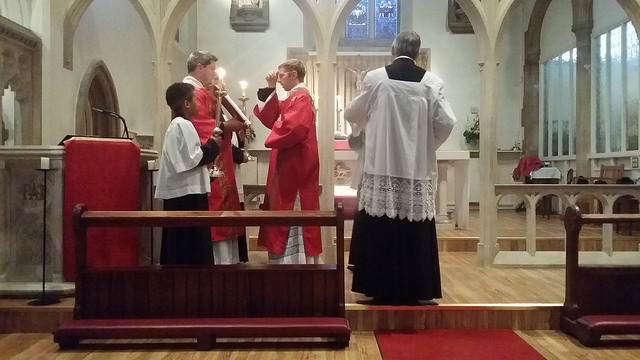Cardinal Sarah, reconciliation and the lectionary

There has been quite a bit of discussion about Cardinal Sarah’s article in La Nef recommending liturgical reconciliation and suggesting ways in which the mutual enrichment which Pope Benedict called for, could be implemented practically. His Eminence suggested that there might be a shared calendar and a shared lectionary so that the two “forms” of the Roman rite could celebrate more feasts together and have the same Scripture readings at Mass.
Fr Raymond de Souza, in the Catholic Herald’s blog, wrote approvingly of the proposals (see: Cardinal Sarah’s challenge to traditionalists), and he was followed the next day by Joseph Shaw, pointing out that the proposals would be unworkable. (See: Why Cardinal Sarah’s liturgical ‘reconciliation’ plan won’t work - see also on Rorate Caeli: A reply to Cardinal Sarah on 'liturgical reconciliation'). Fr Zuhlsdorf picked up on the discussion and added his own observations. (Wherein Fr. Z rants: Card. Sarah’s proposals for “mutual enrichment”)
One problem is that of experience. Most of those Catholics who regularly participate at Masses celebrated in the usus antiquior have experienced the modern rite; most Catholics who regularly participate in the modern rite have not experienced the usus antiquior and do not really understand its attraction or its salient features when compared with the rite that they know. Some regular experience of celebrating the usus antiquior would lead most priests (or Cardinals) to understand the impossibility of forming a common reformed rite that would really be the usus antiquior which Pope Benedict understood as being attractive to many people, and which he said could not be suddenly considered forbidden or harmful.
In an update, Fr de Souza has written again today (Traditionalists reject Cardinal Sarah’s liturgical reconciliation plan – but that’s not a problem) accepting that “The more pressing issue by far is the enrichment of the OF, which can happily be done independent of any changes in the EF.” Fr de Souza’s article is instructive in that he seems to find it a surprise that some traditionalists should deny that the new three-year OF lectionary is superior to the one-year EF lectionary. He maintains that the superiority of the OF lectionary is a matter of broad consensus, and continues “I understated that, actually; it is nearly a unanimous position even in conservative liturgical circles.”
Here again, I think that there is a problem of lack of experience of the two “forms” of the Roman rite, and perhaps an unfortunate gulf that is growing, between “traditionalists” and “conservatives.” Rather than attempt a reconciliation, or merging of the two forms, something that would be highly controversial at the present time, perhaps the most important “reconciliation” that we need at the moment is between “traditionalists” and “conservatives” as people, who are of one mind in many of the most important issues in the life of the Church.
I would also gently urge that there needs to be greater awareness of the real work that is being done on the liturgy by traditionalist scholars. To take an example that is relevant to the current debate: only last year, Matthew P. Hazell published what is volume I in Lectionary Study Aids: Index Lectionum: A Comparative Table of Readings for the Ordinary and Extraordinary Forms of the Roman Rite. His blog Lectionary Study Aids has other resources that would be useful for anyone interested in actually studying the question. His book has a Foreword by Peter Kwasniewski and consists of comparative tables by which the lectionaries of the modern rite and the usus antiquior can be compared to see which passages of scripture are included or omitted.
Thanks to Matthew Hazell, it is no longer necessary to rely on feelings or impressions when forming an opinion about the lectionary of the modern rite and it is possible to go beyond the simple assessment that it has lots more verses of the bible and therefore must be so much better. In the Foreword, Peter Kwasniewski makes a brief start on analysis of the modern lectionary, looking at, among other problems, Old Testament omissions, loss of Johannine material, omission of morally demanding texts (notoriously 1 Cor 11.27-29), and reductive redistribution.
Those who would defend the superiority of the modern lectionary cannot simply default to the position that “everybody” knows it is better because it has a higher biblical word-count; there is a real debate to be had, and an increasing amount of source material to be used.
I agree with Fr de Souza that “the enrichment of the OF” is the pressing issue, though I would add that if, as he says, only a tiny minority of Catholics have experience of the usus antiquior, it would work to the good of the Church if that were gently rectified and the older form of the Roman rite brought more widely into general use. As a principle of reform, or enrichment of the modern rite, I would suggest that permission would be a better route than imposition – if for no other reason than to avoid the need for even more reconciliation. Cardinal Sarah himself has made one or two suggestions in this regard: the possibility of using the traditional offertory prayers, and permission to use the prayers at the foot of the altar to begin Mass. We could add Cardinal Ratzinger’s suggestion (in his book “The Spirit of the Liturgy”) of allowing the silent canon.
As many commentators have observed, there is really no great problem in having more than one use or rite. In the West, we have had several minor differences in use for centuries (Milan, Toledo, England, Dominican, Carmelite and so on) and the Church has gone out of her way to express respect for the venerable Eastern rites. It should not be so difficult for us to accommodate the most ancient use of the Roman rite within the fold.
[Photo credit: Mulier Fortis]

